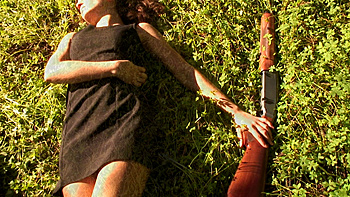- Steven Allan
- Mike Allen
- Arvindh Baburam
- Tim Bouckley
- Shing Tat Chung
- Boudicca Paloma Collins
- Patricia Vidal Delgado
- Frances Drayson
- Rupert Emerton
- Duncan Harrison
- Sheera Jacobs
- Ji Seon Kim
- Annie Lord
- Ingrid Mackay
- Liz Morris
- Alice Newsholme
- Nengi Omuku
- Bradley Zero Phillip
- Alessandra Price
- James Robertson
- Simone Rowat
- Josephine Rowntree
- Nina Royle
- Michael C. Schuller
- Daniel Schwitzer
- Susan Stainman
- Katie Surridge
- Mayu Taniguchi
- Yue Teng
- Jason Waller
- Katherine Waller
- Francesca Wheeler
- L. Wormell
- Jinwoo Yoo
- Yang Zhu
BA

Girl With Gun, video, 10 minutes, 2010
Girl with Gun developed from my interest in the psychological and archetypal aspects of the phallic female. My intention was to embody this symbol as a means to expose the fraudulent phallus and to reject the insidious politics of castration versus phallic potency.
The voice-over incorporates quotes from Joan Riviere's 1929 essay Womanliness as a Masquerade and this frames the interaction between 'The Girl' and 'The Gun' as a visual metaphor for gender dynamics within a heterosexual relationship.
I was also greatly influenced by Elizabeth Cowie's book, Representing the Woman: Cinema and Psychoanalysis, which explores the power dichotomy of having the phallus and being the phallus, whereby the man requires the unconscious phallic potential of the woman (who perceives herself as castrated) in order to confidently exercise the full extent of his phallic power.
The filmic space is that of the unconscious and therefore the ritual of burial, to quote Hélène Cixous, 'puts up the immurement of repressions and amnesia into concrete form'. In Three Steps on the Ladder of Writing, Cixous wrote (here in relation to Clarice Lispector's short story The Crime of the Mathematics Professor):
We/he must bury. We constantly believe we must repress, forget and bury. Yet this isn't true. The desire to bury hides a much more twisted desire: Man wants to be seen burying - wants to be discovered in the middle of burying (...)
Man only half-buries the dog.
[The Girl only half-buries The Gun].
In fact, he exhibits the burial in such a way it seems like a disinterment.
He must unbury the burying, which is equivalent to bringing what has been repressed back to the surface of consciousness.
The character of 'The Girl' refuses to repress the trauma of lack and goes beyond the limits of castration towards a happy death.

Black Sand, video, eight-monitor video installation, 2010
My video installation Black Sand consists of eight single-shot one-minute sequences. A written caption at the start of each film links the image directly to the narrative content of the voice-over.
This voice-over communicates stories of discontent, longing and heartbreak; creating an overall image of disenchantment. Some of these monlogues include quotes from the Roland Barthes' book, A Lover's Discourse: Fragments, which has been of great interest to me. In this volume, Barthes has sensitively psychoanalysed the lover's pathological condition and exposed the deep-seated neurosis that lies at the root of feeling-states such as 'love' and 'desire'.
In Black Sand, the subjects are anonymous and the locations are non-specific because these narratives are universal and could apply to anybody, anywhere in the world. Each sequence thereby becomes a 'video-postcard' from an indeterminate subject-location.
Slavoj Žižek wrote in gaze and voice as love objects, "voice does not simply persist at a different level with regard to what we see, it rather points toward a gap in the field of the visible, toward the dimension of what eludes our gaze. In other words, their relationship is mediated by an impossibility: ultimately, we hear things because we cannot see everything."
I have worked extensively with the cinematic convention of the voice-over and here, to paraphrase Žižek, I am interested in the way in which the voice-over can compensate for the blind spot of the image: in Black Sand the detailed poetry of the voice-over creates a specific emotional atmosphere which contrasts with the generic sterility of the single-shot.

Monument, performance, 5 minutes, 2010
www.pvdelgado.com
- Georgina Amos
- Gyeong-Yoon An
- Orly Aviv
- Natasha Bailey
- Gabriele Beveridge
- Luca Bolognesi
- Elia Cantori
- Patricia Chi
- Hannah Chiswell
- Joe Clark
- Rose Davey
- Steven Dickie
- Claire Dorsett
- Ramon Fernandez
- Richard Forbes-Hamilton
- Joe Graham
- Andrea Greenwood
- Erin Gutierrez
- Olof Helga Helgadottir
- Chien-Ni Hung
- Shan Hur
- Kentaro Ikegami
- Yoonjin Jung
- Chinwook Kim
- Hyo Myoung Kim
- Rebecca Lennon
- Eva Lis
- Paul Magee
- Lindsay Mapes
- Victor Mavedzenge
- William May-Robinson
- Rory McCartney
- Paulina Michnowska
- Donal Moloney
- Aaron Murphy
- Nika Neelova
- Stephanie O'Connor
- Chloe Ostmo
- Junko Otake
- Hyung Jin Park
- Yeojoo Park
- Tessa Power
- Thomas Qualmann
- Saad Ahmed Qureshi
- Oliver Rafferty
- Ryan Riddington
- Mike Salter
- Peter Sant
- Holly Slingsby
- Ayuko Sugiura
- Kay Tabernacle
- Diana Taylor
- Amanda Wasielewski
- Gavin Weber
- Sarah Kate Wilson
- Jayne Wilton
- Jung Woon
- Eleanor Wright
- Lisui Zhang
MA/MFA